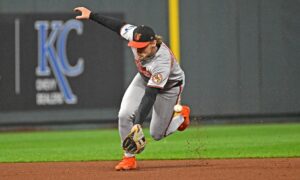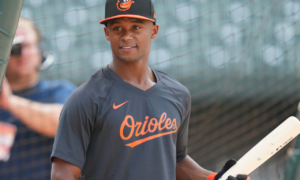SCROLL DOWN TO READ ARTICLE
There were nine and then there were seven. Seven O’s pitchers who are starting rotation candidates for Opening Day. And the first few days of spring training show us once again how fragile starting pitching can be and how having depth is key.
And health. Keep those pitchers out there every five or six days.
Since spring training began on Thursday we already learned that lefty Trevor Rogers will miss the start of the year with a partial dislocation of his right kneecap. It happened in a January workout. And then came word that right-handed pitching prospect Chayce McDermott, ranked as the O’s No. 5 prospect by Baseball America, reported to camp with a mild lat/teres strain. Manager Brandon Hyde said McDermott could begin a throwing progression in 10-to-14 days. He might return sooner than Rogers.
So, yes, one or two starting pitching injuries thins the depth. For those who assumed right-hander Albert Suarez was a bullpen guy to start camp, well now he needs to get stretched out to maintain some rotation depth.
CONTINUE READING BELOW
Just a few days ago the projection was for Zach Eflin, Grayson Rodriguez, Dean Kremer, Charlie Morton and Tomoyuki Sugano to make up the first five. Behind them would be Rogers, McDermott, Cade Povich and Brandon Young.
Keeping your starting rotation on the field proved huge for the 2023 AL East champion, 101-win Orioles. They had three starters – Kyle Gibson, Kremer and Kyle Bradish – total 30 or more starts and pitch at least 168 2/3. And they had five who made 20 or more starts.
Last year, when they dipped to 91 wins, one pitcher, Corbin Burnes, made 30 or more starts. Four made 20 or more. Rotation depth is important and for the O’s, it’s already being tested.
They had a tough time without Westy: The sight of a healthy Jordan Westburg for the Orioles is a reassuring one in Saraosta. Westburg, who turns 26 on Tuesday, played in 107 games last season. When he was out, the difference in performance for the lineup and the win-loss column was vast.
It can’t only be about one player, but the stats do tell a story.
CONTINUE READING BELOW
Westburg produced a .792 OPS last year and played in his first All-Star Game. The Orioles missed him between late July and late September after his right hand was fractured by a pitch.
“We saw what happened when we lost Westy,” Hyde told reporters over the weekend at Ed Smith Stadium. “That really affected us. Affected our lineup, kind of affected our toughness in the order, as well as the defense versatility.”
The Orioles played 109 games through last July 31st when Westburg got hit in the hand. They went 65-44 (.596), a 97-win pace, and as a team produced a .774 OPS and scored 5.1 runs per game through that date.
He did not return until September 22nd. Through September 21st, the Orioles went 21-25 (.457), a 74-win pace, while producing an OPS of .686 and scoring 4.2 runs per game.
In addition to those numbers, Westburg is a clutch player. Last season, he had a .923 OPS when batting with runners in scoring position. In what baseball-reference.com deems as high leverage spots, he hit .400 with an OPS of 1.105. These are situations that can dramatically change win probability.
The close-knit Orioles: We know the Orioles have a tight clubhouse. Many of their young players came up together.
Tommy Joseph was an assistant hitting coach with Seattle last season and joins the Orioles in a similar role this year. He immediately noticed the closeness among the players.
“In terms of the environment and the culture, just being here a couple days, you can tell it’s very special,” he told the media in Florida as was noted in an article on MASNSports.com. “They’ve built something very special, and the players really bought in on everything here.
“I would say, honestly, the players themselves are friends and they push each other every day. They just have unique relationships that really know how to get the best out of each other. You always want to be a part of good teams and good culture.”










